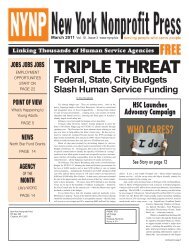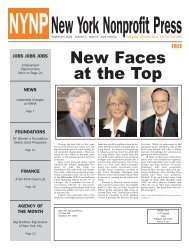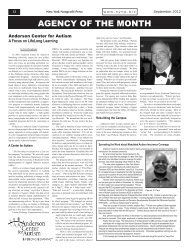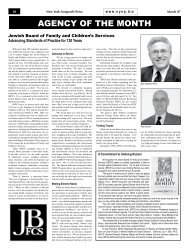January Edition 2010 - New York Nonprofit Press
January Edition 2010 - New York Nonprofit Press
January Edition 2010 - New York Nonprofit Press
You also want an ePaper? Increase the reach of your titles
YUMPU automatically turns print PDFs into web optimized ePapers that Google loves.
<strong>January</strong> ‘10 <strong>New</strong> <strong>York</strong> Nonprofi t <strong>Press</strong> www.nynp.biz 15<br />
An overriding trend in today’s nonprofit<br />
marketplace is change. This change<br />
has been so significant that today’s nonprofit<br />
organization is very different than<br />
the nonprofit organization of a decade ago.<br />
<strong>Nonprofit</strong> managers who understand<br />
how the sector has changed and have been<br />
able to shift their thinking to effectively<br />
deal with new critical issues will be able<br />
to help their organizations flourish over the<br />
next few years.<br />
One of the most dramatic changes in<br />
the sector can be seen in the area of staffing.<br />
For many nonprofit executives, a reduced<br />
workforce has made it difficult to deliver<br />
programs and services to fulfill their<br />
organization’s mission. In addition, due to<br />
a tide of layoffs in managerial ranks, many<br />
believe organizations will face a shortage<br />
of qualified management candidates over<br />
the next five to ten years as well.<br />
Despite tight budgets, as the economy<br />
continues to improve, nonprofits will need<br />
to fill vacancies and add new positions in<br />
<strong>2010</strong>. How well an organization flourishes<br />
over the next few years will depend on how<br />
well it rebuilds its workforce and how skillfully<br />
management can handle current tasks<br />
at hand as well as prepare for the future.<br />
We suggest the following to our clients:<br />
Resetting Priorities<br />
Facing the new reality requires a resetting<br />
of organizational priorities. Certainly<br />
this past year has taught us a different mind<br />
set and this may be a good time to evaluate<br />
organizational capabilities and staff talent.<br />
Reworking job descriptions, evaluating the<br />
effectiveness of performance reviews, making<br />
certain that salaries are competitive with<br />
similar organizations in the marketplace,<br />
reviewing processes and procedures are all<br />
critical issues that should be addressed now<br />
rather than later.<br />
Retaining Staff<br />
One of the most important objectives<br />
for every executive is to retain as many talented<br />
employees for as long as possible.<br />
Studies show that the vast majority of employees<br />
stay with an organization in which<br />
they feel comfortable and appreciated. Encouraging<br />
professional and career growth,<br />
paying a fair salary, and promoting from<br />
within are ways to ensure that you retain<br />
the best staff you can.<br />
Using Temps<br />
STRENGTHENING NONPROFITS<br />
Planning for the Future in a Downsized Organization<br />
Learning how to use temps is the first<br />
line of defense in managing workloads with<br />
a reduced workforce. Temps have been<br />
used by the for-profit sector for decades as<br />
a cost effective way to manage labor needs.<br />
<strong>Nonprofit</strong> executives who understand how<br />
to use temps to fill in staff deficiencies, end<br />
up saving time, effort, and money while accomplishing<br />
all that needs to get done. At<br />
a time when a reduced staff can slow down<br />
projects, hiring temps is a sensible management<br />
tool and a relief to the staff you have.<br />
Outsourcing Services<br />
Outsourcing is another cost effective<br />
way to respond to the need for greater expertise<br />
in specialized areas. Outsourcing<br />
administrative functions, like payroll, can<br />
be used to better leverage existing resources<br />
by focusing staff on core functions most<br />
vital to creating value for the organization.<br />
As a result, staff can be more focused on<br />
core activities while support services are<br />
efficiently provided by outside sources.<br />
Hiring Staff<br />
Develop a plan for the next few years<br />
on how to bring in the staff you need as<br />
your organization’s finances improve.<br />
Competing for top talent will be your organization’s<br />
top priority and most critical<br />
issue. Because of how important the employees<br />
you hire are to the success of your<br />
organization, we suggest the following to<br />
all our clients:<br />
Learn how to find and hire the “right”<br />
staff for your organization. To develop<br />
an organization of top performers, you<br />
must develop your skills as a talent scout.<br />
Be on the look out for talent all the time.<br />
When you meet anyone who impresses<br />
you, ask if you can get in touch when<br />
a job opening occurs at your organization.<br />
If they are not interested, ask them<br />
to recommend someone they feel is as<br />
good as they are.<br />
Never search for the best candidate to<br />
hire – always seek the right candidate<br />
for your organization. Numerous studies<br />
have shown that employees who stay<br />
at their jobs are those where the fit is<br />
right. Know the culture of your organization<br />
and what kind of employee will<br />
fit into your environment.<br />
Make certain that you can compete effectively<br />
in the talent marketplace by offering<br />
salaries that are in the same range<br />
as similar organizations. Losing a choice<br />
candidate (by usually saving a relatively<br />
small amount of money) and settling for<br />
someone with less experience may not<br />
be the most cost effective decision for<br />
your organization in the long run.<br />
The Strengthening <strong>Nonprofit</strong>s column is made possible through<br />
the financial support of United Way of <strong>New</strong> <strong>York</strong> City (UWNYC).<br />
The views expressed in the column are those of the author, and<br />
are not necessarily those of UWNYC. UWNYC does not edit or<br />
control the content of this column. www.unitedwaynyc.org<br />
Do not hire based only on the skills<br />
listed in the job description. Seek candidates<br />
with the essential skills to do<br />
the work required and then look for attributes<br />
that make good employees – intelligent,<br />
hardworking, problem solving<br />
team players.<br />
Learn how to speak about your organization<br />
emphasizing your organization’s<br />
major points of appeal. Learn how to<br />
sell your organization. Because you are<br />
looking for the right person who will<br />
thrive in your organization, your organization<br />
is perfect for that person.<br />
Learn how to interview. A Harvard<br />
study notes that more than 75% of turnover<br />
can be traced to poor interviewing<br />
skills and processes. If you have an appropriate<br />
job description, learn how to<br />
interview and then seek the right candidate<br />
to fit your organization, you will<br />
be more assured of hiring a productive<br />
employee who stays.<br />
Listen to your instincts. It is said that<br />
an employer decides to hire someone<br />
within the first 30 seconds of an interview.<br />
Good instincts can be developed<br />
and honed by paying attention to detail.<br />
Learn to listen to your instincts.<br />
Speed up your organization’s operating<br />
velocity. When you find the candidate<br />
that you feel is right for your organization,<br />
hire quickly. More organizations<br />
lose the hire of their choice by taking too<br />
long to make an offer and the candidate<br />
is hired by another organization. Move<br />
as fast as you can.<br />
Learn how to use a search firm when you<br />
need one – preferably one that specializes<br />
in nonprofit staffing. If you are not<br />
finding the kind of staff your organization<br />
requires or when important staffing<br />
decisions are at stake, a good search firm<br />
will help focus your energy for the best<br />
results. While you only conduct a search<br />
when you have a need to hire, a search<br />
firm conducts searches every day so they<br />
have experience and connections to the<br />
best talent and can reach people who you<br />
may not be able to reach in the marketplace.<br />
In summary, how well an organization<br />
thrives over the next few years will be determined<br />
by the ability of its executives and<br />
managers to bring in the right talent and rebuild<br />
a strong and effective workforce in<br />
their organizations.<br />
Gayle A. Brandel is President/CEO<br />
of Professionals for NonProfits. www.nonprofitstaffing.com











